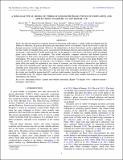| dc.contributor.author | Demory, Brice-Olivier | |
| dc.contributor.author | Seager, Sara | |
| dc.contributor.author | Lewis, Nikole | |
| dc.contributor.author | Showman, Adam P. | |
| dc.contributor.author | Hu, Renyu, Ph. D. Massachusetts Institute of Technology | |
| dc.date.accessioned | 2015-05-26T20:07:03Z | |
| dc.date.available | 2015-05-26T20:07:03Z | |
| dc.date.issued | 2015-03 | |
| dc.date.submitted | 2014-09 | |
| dc.identifier.issn | 1538-4357 | |
| dc.identifier.issn | 0004-637X | |
| dc.identifier.uri | http://hdl.handle.net/1721.1/97083 | |
| dc.description.abstract | Kepler has detected numerous exoplanet transits by measuring stellar light in a single visible-wavelength band. In addition to detection, the precise photometry provides phase curves of exoplanets, which can be used to study the dynamic processes on these planets. However, the interpretation of these observations can be complicated by the fact that visible-wavelength phase curves can represent both thermal emission and scattering from the planets. Here we present a semi-analytical model framework that can be applied to study Kepler and future visible-wavelength phase curve observations of exoplanets. The model efficiently computes reflection and thermal emission components for both rocky and gaseous planets, considering both homogeneous and inhomogeneous surfaces or atmospheres. We analyze the phase curves of the gaseous planet Kepler-7 b and the rocky planet Kepler-10 b using the model. In general, we find that a hot exoplanet's visible-wavelength phase curve having a significant phase offset can usually be explained by two classes of solutions: one class requires a thermal hot spot shifted to one side of the substellar point, and the other class requires reflective clouds concentrated on the same side of the substellar point. Particularly for Kepler-7 b, reflective clouds located on the west side of the substellar point can best explain its phase curve. The reflectivity of the clear part of the atmosphere should be less than 7% and that of the cloudy part should be greater than 80%, and the cloud boundary should be located at 11° ± 3° to the west of the substellar point. We suggest single-band photometry surveys could yield valuable information on exoplanet atmospheres and surfaces. | en_US |
| dc.language.iso | en_US | |
| dc.publisher | IOP Publishing | en_US |
| dc.relation.isversionof | http://dx.doi.org/10.1088/0004-637x/802/1/51 | en_US |
| dc.rights | Article is made available in accordance with the publisher's policy and may be subject to US copyright law. Please refer to the publisher's site for terms of use. | en_US |
| dc.source | IOP Publishing | en_US |
| dc.title | A SEMI-ANALYTICAL MODEL OF VISIBLE-WAVELENGTH PHASE CURVES OF EXOPLANETS AND APPLICATIONS TO KEPLER-7 B AND KEPLER-10 B | en_US |
| dc.type | Article | en_US |
| dc.identifier.citation | Hu, Renyu, Brice-Olivier Demory, Sara Seager, Nikole Lewis, and Adam P. Showman. “A SEMI-ANALYTICAL MODEL OF VISIBLE-WAVELENGTH PHASE CURVES OF EXOPLANETS AND APPLICATIONS TO KEPLER-7 B AND KEPLER-10 B.” The Astrophysical Journal 802, no. 1 (March 20, 2015): 51. © 2015 The American Astronomical Society | en_US |
| dc.contributor.department | Massachusetts Institute of Technology. Department of Earth, Atmospheric, and Planetary Sciences | en_US |
| dc.contributor.department | Massachusetts Institute of Technology. Department of Physics | en_US |
| dc.contributor.mitauthor | Seager, Sara | en_US |
| dc.contributor.mitauthor | Lewis, Nikole | en_US |
| dc.relation.journal | The Astrophysical Journal | en_US |
| dc.eprint.version | Final published version | en_US |
| dc.type.uri | http://purl.org/eprint/type/JournalArticle | en_US |
| eprint.status | http://purl.org/eprint/status/PeerReviewed | en_US |
| dspace.orderedauthors | Hu, Renyu; Demory, Brice-Olivier; Seager, Sara; Lewis, Nikole; Showman, Adam P. | en_US |
| dc.identifier.orcid | https://orcid.org/0000-0002-6892-6948 | |
| mit.license | PUBLISHER_POLICY | en_US |
| mit.metadata.status | Complete | |
